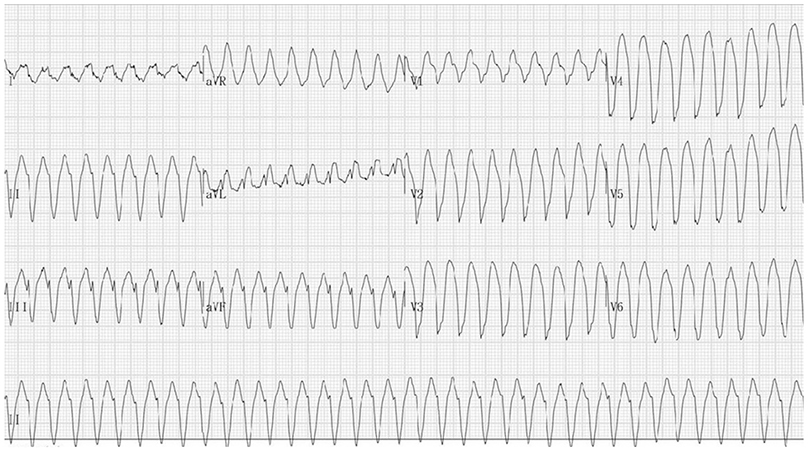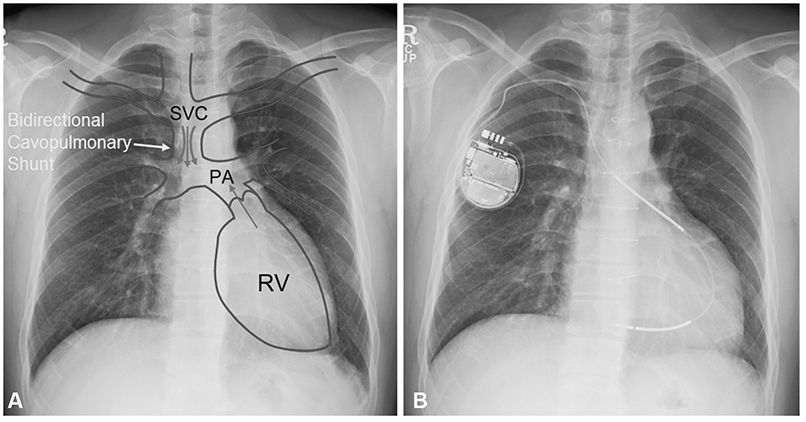Korean Circ J.
2015 Jul;45(4):344-347. 10.4070/kcj.2015.45.4.344.
Transvascular Implantation of an Implantable Cardioverter-Defibrillator in a Patient Who has Undergone One-and-a-Half Ventricle Repair
- Affiliations
-
- 1Department of Cardiology, Arrhythmia Center, Severance Cardiovascular Hospital, Yonsei University College of Medicine, Seoul, Korea.
- 2Department of Pediatric Cardiology, Arrhythmia Center, Severance Cardiovascular Hospital, Yonsei University College of Medicine, Seoul, Korea. pednk@yuhs.ac
- KMID: 1964109
- DOI: http://doi.org/10.4070/kcj.2015.45.4.344
Abstract
- Implantable cardioverter-defibrillator (ICD) therapy is acknowledged as a valid treatment method for the effective prevention of sudden cardiac death, which is a major cause of mortality in adult congenital heart disease patients. But ICD implantation by the conventional transvascular approach is not always possible in patients who have undergone palliative surgery due to congenital and structural heart disease. Here, we report a case in which an ICD was transvascularly implanted in an arrhythmogenic right ventricular cardiomyopathy patient who had undergone a one-and-a-half ventricle repair.
Keyword
MeSH Terms
Figure
Reference
-
1. Winkle RA, Mead RH, Ruder MA, et al. Long-term outcome with the automatic implantable cardioverter-defibrillator. J Am Coll Cardiol. 1989; 13:1353–1361.2. Koyak Z, Harris L, de Groot JR, et al. Sudden cardiac death in adult congenital heart disease. Circulation. 2012; 126:1944–1954.3. Mondésert B, Khairy P. Implantable cardioverter-defibrillators in congenital heart disease. Curr Opin Cardiol. 2014; 29:45–52.4. Cannon BC, Friedman RA, Fenrich AL, Fraser CD, McKenzie ED, Kertesz NJ. Innovative techniques for placement of implantable cardioverter-defibrillator leads in patients with limited venous access to the heart. Pacing Clin Electrophysiol. 2006; 29:181–187.5. Uyeda T, Inoue K, Sato J, et al. Outcome of implantable cardioverter defibrillator therapy for congenital heart disease. Pediatr Int. 2012; 54:379–382.6. Nery PB, Green MS, Khairy P, Alhebaishi Y, Hendry P, Birnie DH. Implantable cardioverter-defibrillator insertion in congenital heart disease without transvenous access to the heart. Can J Cardiol. 2013; 29:254.7. Khanna AD, Warnes CA, Phillips SD, Lin G, Brady PA. Single-center experience with implantable cardioverter-defibrillators in adults with complex congenital heart disease. Am J Cardiol. 2011; 108:729–734.8. Akerström F, Arias MA, Pachón M, Puchol A, Jiménez-López J. Subcutaneous implantable defibrillator: state-of-the art 2013. World J Cardiol. 2013; 5:347–354.9. Lambiase PD, Barr C, Theuns DA, et al. Worldwide experience with a totally subcutaneous implantable defibrillator: early results from the EFFORTLESS S-ICD Registry. Eur Heart J. 2014; 35:1657–1665.10. Kreutzer C, Mayorquim RC, Kreutzer GO, et al. Experience with one and a half ventricle repair. J Thorac Cardiovasc Surg. 1999; 117:662–668.
- Full Text Links
- Actions
-
Cited
- CITED
-
- Close
- Share
- Similar articles
-
- Transvenous Implantation of an Implantable Cardioverter Defibrillator in a Patient Who Had Undergone Tricuspid Valve Replacement
- Implantable Cardioverter-Defibrillator (ICD) Therapy: Initial Clinical Experience in 6 Patients
- A Case Report of the Patient Implanted with Automatic Implantable Cardioverter Defibrillator (AICD) Subject to 3rd Molar Extraction using Target Controlled Infusion of Propofol and Remifentanil: A Case Report
- Thrombosis in the Left Ventricle after Implantable Cardioverter-Defibrillator Implantation: A Rare Cause of Systemic Thromboembolism
- Combined Subpectoral Implantation of Implantable Cardioverter-Defibrillator and Augmentation Mammoplasty in a Young Female Patient




